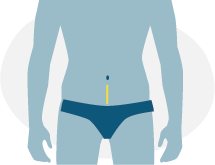The surgical technique we use at Instituto Clavel is based on a combination of the latest advances, extensive experience, and the results achieved. The following explains our reasons for choosing the anterior and lateral approach techniques.
Anterior approach
The anterior approach to the spinal column consists of operating on the spine via the retroperitoneum, a natural path of entry we all have located in the abdomen.
Depending on the surgery, the patient, or the implant that needs to be used, the surgeon chooses the most appropriate approach in each case (anterior, oblique or lateral). No matter which of these approaches is used, the surgical path always lies through the retroperitoneum. Once this is done, we reach the spinal column aided by special spacers without causing any tissue damage.
The advantages of this type of approach are:
- It allows a non-traumatic access to the spine, as it is reached through a natural path of the body.
- It avoids manipulating the nerve structures, because the spinal canal where they are located is at the back of the spine.
- The damaged disc is completely removed and replaced with a prosthetic disc or fusion cage.
- Whether by anterior or lateral approach, the success rate is greater than 95% (much higher than using the classic posterior approach).
- It is possible to correct deformities with fusion cages, without the complications inherent in a posterior approach.
- Length of hospital stay is shorter, and therefore, the rehabilitation time is also reduced.


.jpg)

